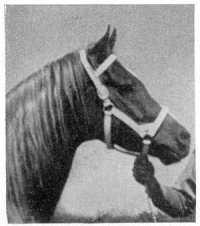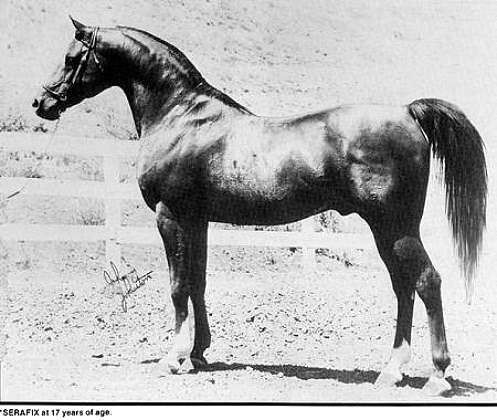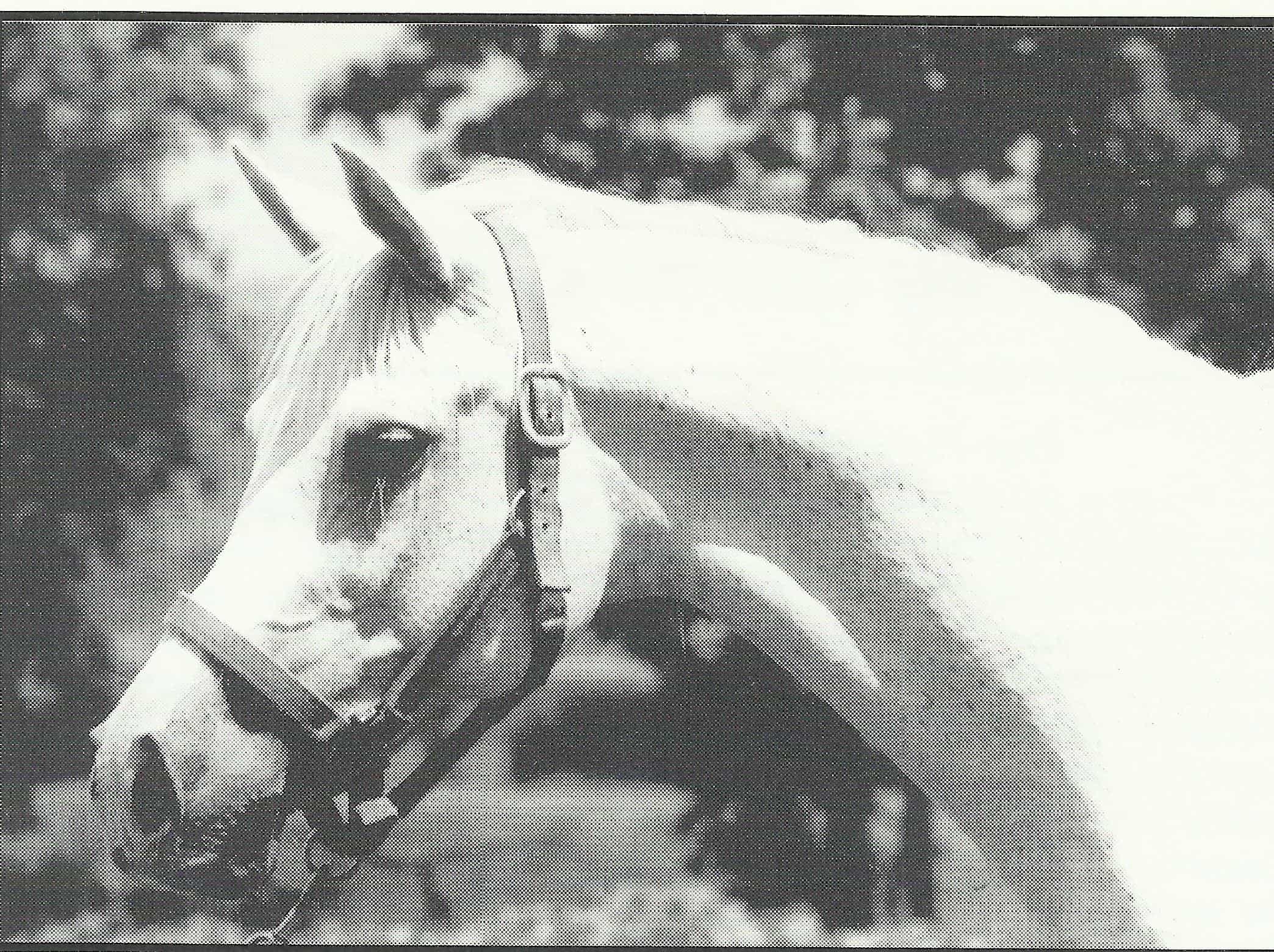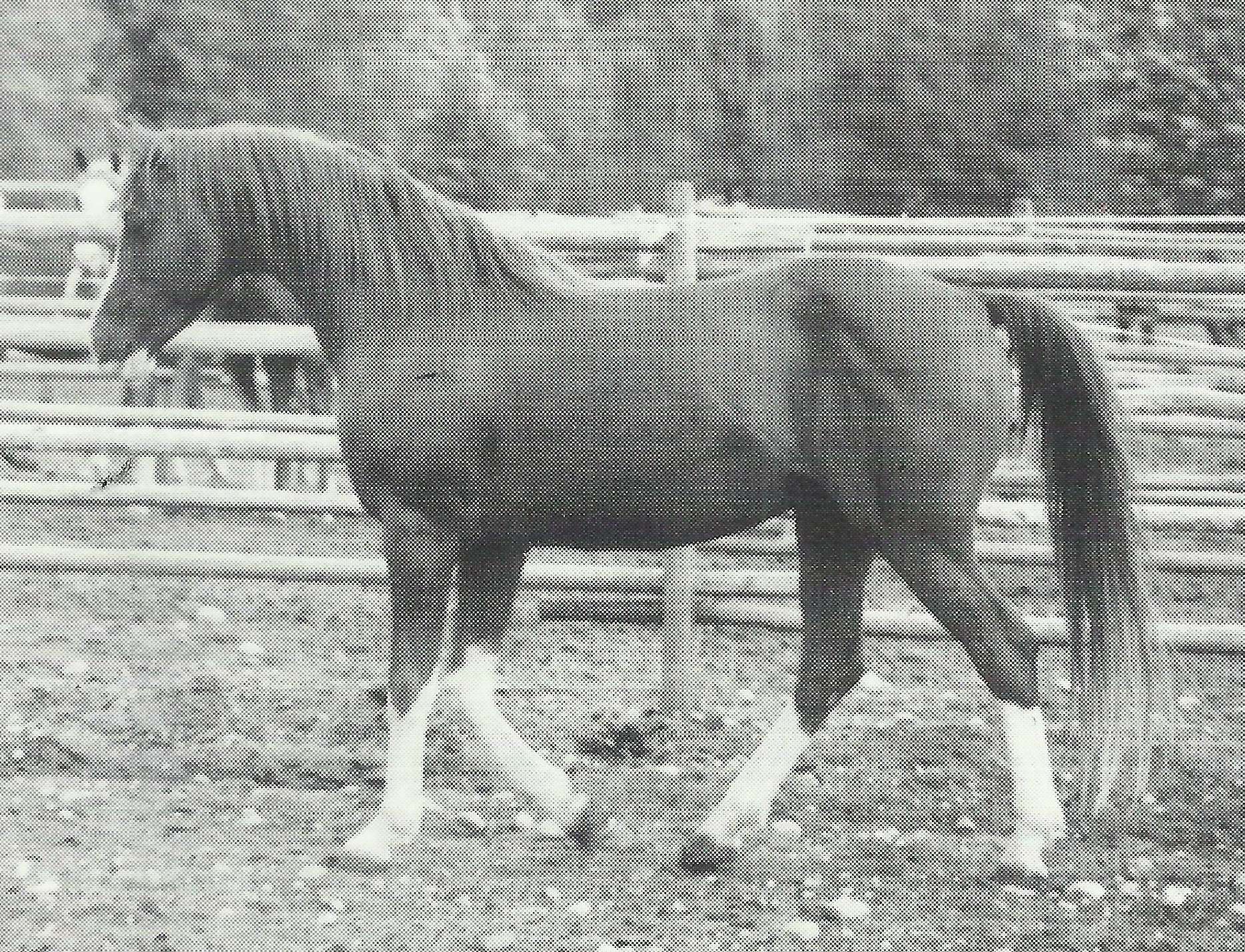By 'The Horse Lover' magazine author
** Originally published in April May 1951 issue of The Horse Lover magazine.
A brief history of the progenitor of the Antez (Harara x Moliah) line; his sons and daughters are carrying on their great sire's reputation in the show ring, and on the track.
Antez (1921 chestnut stallion) was foaled in California from stock tracing entirely to the horses brought from the Arabian desert by Homer Davenport in 1906. His sire Harara and his dam Moliah had been bred at the Hingham Stock Farm in Massachusetts by Mr. Peter B. Bradley.
Later Antez was acquired by Mr. W.K.Kellogg (in 1925 when Antez was age 4 - he (Antez) is also shown in the header/article photo at the top of the page with Mr. Kellogg) at whose Pomona California Ranch the horse was featured as one of the "tops" of that famous "Romance of Pomona" ranch and for several years he was many times a champion at shows on the West coast in halter classes as well as being first on several occasions at five gaits under saddle.
In 1933 at age of 12 years he was purchased by General J.M. Dickinson of Tennessee.
He was used at Dickinson's Travelers Rest Arabian Stud Farm for breeding purposes and in the 1933 National Arabian show he stood 3rd in the Mature Stallion championships and his daughter Fayadan won the championship over about a dozen other fine weanlings. Since then his sons and daughters have gone on to win many honors in the show rings of America.
Antez today stands undisputed as one of best sires in America as to passing on his strong breed character to his get and they in turn are passing it on to their produce.
In Tennessee he was used as a saddle mount by the 13-year-old Miss Peggy Dickinson and he made an ideal young girl's mount, lamb-like in gentleness, yet full of life and beautiful enough to fit any horseman's dream.
He was used and shown considerably in the driving or vehicle classes where he moved out brilliantly in the harness.
At Travelers Rest he was ridden 12 hours a day for five consecutive days in an endurance test carrying full weights where he finished perfectly sound, normal temperature and pulse -- still looking for more distance to conquer.
Though featured on the Pacific Coast where he won wide popularity, Antez's ability to race was unnoticed and the same held true for some years after his coming to Tennessee though he gave the seemingly blind folks with whom he had been associated all his life, evidence and opportunity to see what his heart must have yearned for and so it was almost by an accident he was given his chance - and this isn't the first accident in horse history as witness the story of the Godolphin. Antez' chance came in the spring of 1933 when as a sporting gesture Mr. Dickinson decided to run an Arabian in the flat mile race for Thoroughbreds on Overton Downs and the logical candidate was the game, hardy, handsome little chestnut, Antez, he unhesitatingly selected, though little dreaming of the startling results that would develop.
His first speed test came on his twelfth birthday, May 1, 1933, when he ran a respectable race against track trained Thoroughbreds at Overton downs, coming in a good third behind horses that stood six and seven inches taller, weighed in racing condition two hundred pounds more - and carrying the identical weight of 150 pounds.
After showing this speed at Overton Downs, Mr. Dickinson decided to try him for a record, which was arranged by courtesy of the late John Early, southwestern governor of the national Trotting Association, and after public advertisement and on fixed days, regardless of weather, Antez made official records at fourth, half and three-quarter mile and the short European race distance of 1200 meters. He equaled the known Arabian records for the quarter and half mile, 14 ½ and 51 seconds (though there is a tradition that a horse traveled the quarter one-half second faster over ninety years ago); equaled an eighty-year-old Arabian record for the half mile, and ran the quarter, half and six furlongs faster than any American-bred Arab on record. Quite a performance for a twelve-year-old stallion that had never been run until his twelfth year!
Shortly after his speed records General Dickinson sold and exported Antez to Poland and during the stud season of 1935 he stood at the Count Potocki Stud - and in 1936 at the Count Rostwordwski Stud.
Later an Arizona breeder of Arabians bought Antez from the Arabian Horse Breeding Society in Poland at a fabulous price and brought him back to America. (1937 or 1938)
Still later, Mr. Kellogg acquired him from Arizona (1942) and put him in the hands of the capable Mr. H.H. Reese where he spent the balance of his illustrious life.
Thus after traveling over half the earth he lies buried only a few miles from his birthplace.
To Antez, who (notice the pronoun) made such a fine record to exemplify the versatility of the Arabian -- the horse lovers of America pay homage to you.
Antez traces in all lines to the horses imported from the Arabian desert by Homer Davenport in 1906. His pedigree is below:
| *Deyr AHR 33 | ||
| Harara AHR 122 | ||
| *Haffia AHR 45 | ||
| Antez AHR 448 | ||
| *Hamrah AHR 28 | ||
| Moliah AHR 109 | ||
| *Wadduda AHR 30 |
* Asterisks denote the individual horse was imported to the United States, including those imported en utero.
Homer Davenport writes interestingly about his trip to the deserts of Arabia and how he secured these horses and others in his book, My Quest of the Arab Horse.

Ankar, a son of Antez, is a prize winning Arabian stallion owned by Mr. and Mrs. Leland Mekeel of Whittier, California. While still a young stallion, his first four colts have also been prizewinners. The strong Antez blood shows marked influence in the offspring and many breeders proudly boast of horses of the Antez line.

Potif is a grandson of both Antez and of Ronek. The sire of Potif is *Latif, a son of Antez. Here again the blood of Antez breeds on, carrying Antez versatility and quality. Potif is owned by Dr. and Mrs. Palmer of Portland, Oregon. This horse has made some notable wins in the show rings of the Northwest. Observers feel that the blood of Skowronek through Ronek complements the Antez line of horses.

Sartez's Arabian World Running Records
Distance - Sartez's time (in 1948) - Previous Record - Horse's Name - Place - Year
Sartez was raced with jockey Onnelee Shook for the first three world record race times, and for all others listed below he was ridden by jockey Buck Griffin.
- ⅛ mile - 11.7 - 15 - Samnite - Madras - 1838
- 240 yards - 12.75 - 24 - Absentee - India - 1844
- ⅜ mile - 36.2 - 51 - Antez - Nashville - 1933
- ¼ mile - 23.15 - 51 - Sir Hugh - Singapore - 1844
- ½ mile - 49.7 - 50.1 - Sartez - Albuquerque - 1947
- 4 ½ furlongs - 56.2 - 59.4 - Sharki - Egypt - 1933
- 5 furlongs - 1:2.8 - 1:3.8 - Mahouza - Iraq - 1925
- 1200 meters - 1:17.8 - 1:21 - Kaszmir - Poland - 1932
- 6 furlongs - 1:17 - 1:18.6 - Nasr - Egypt - 1923
- 1400 meters - 1:32.6 - 1:37 - Kaszmir - Poland - 1932
- 7 furlongs - 1:31.6 - 1:32 - Taj Atiyah - Iraq - 1928
- 1600 meters - 1:45.5 - 1:47.5 - Kaszmir - Poland - 1934
- 1 mile - 1:45.2 - 1:46 - Kowkab - Iraq - 1924
- 1800 meters - 1:59.3 - 2:3.5 - Hadjar - Poland - 1936
- 1 ⅛ miles - 2:0.0 - 2:3.6 - Balance - Egypt - 1933
- 1 ¼ miles - 2:17.1 - 2:20.0 - Nasr - Egypt - 1924
- 1 ⅜ miles - 2:32.8 - 2:34.0 - King John - Egypt - 1929
- 2100 meters - 2:23.8 - 2:30.0 - Mabrucha - Poland - 1932
- 2400 meters 2:46.5 - 2:49.0 - Sart - Poland - 1937
Last Updated: April 25th, 2019





Comments
No Comments